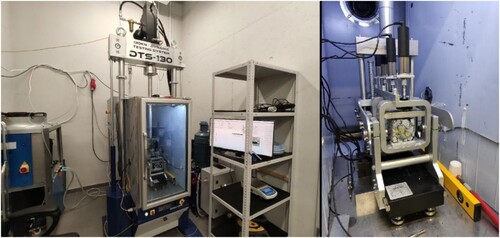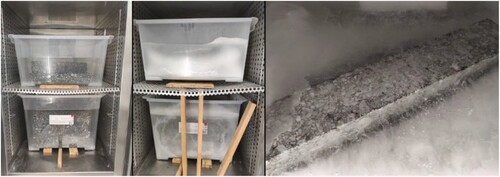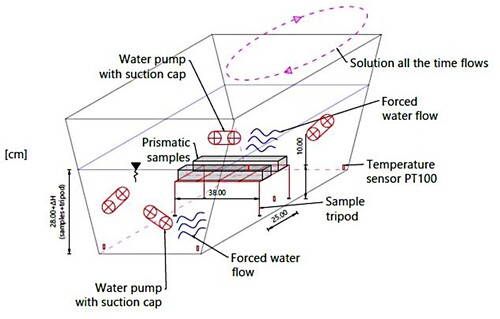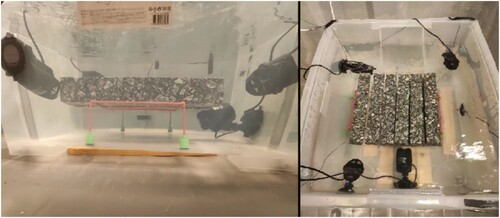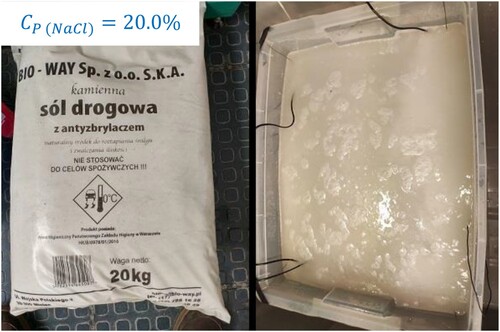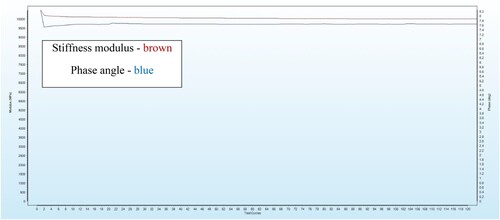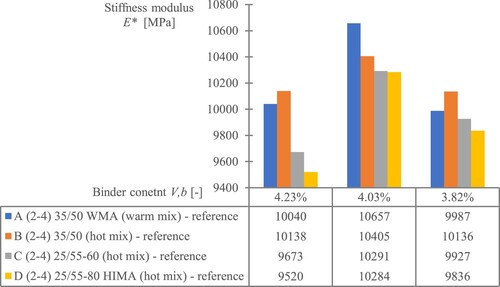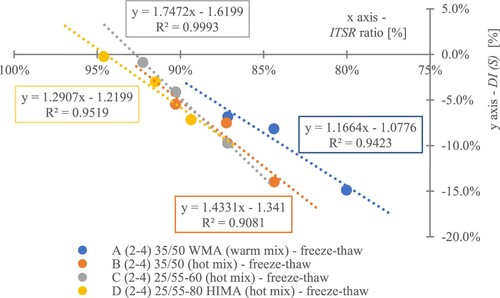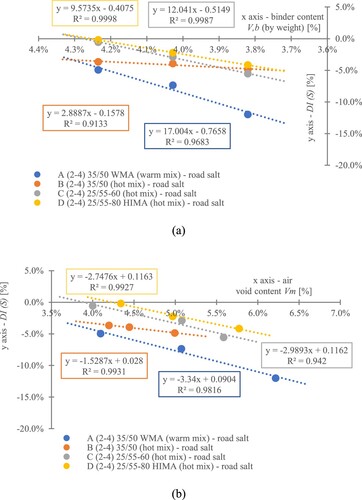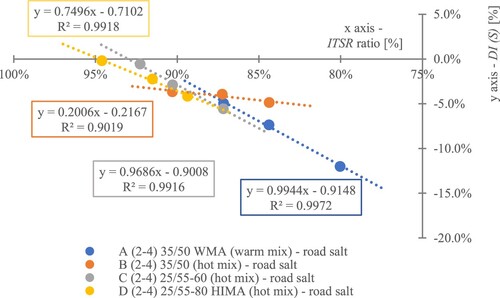 ?Mathematical formulae have been encoded as MathML and are displayed in this HTML version using MathJax in order to improve their display. Uncheck the box to turn MathJax off. This feature requires Javascript. Click on a formula to zoom.
?Mathematical formulae have been encoded as MathML and are displayed in this HTML version using MathJax in order to improve their display. Uncheck the box to turn MathJax off. This feature requires Javascript. Click on a formula to zoom.Abstract
Water, frost, and road salt are important environmental factors that affect the durability of the entire pavement structure e.g. during the winter season or in regions located above sea zones. A proprietary experimental method was used to investigate the influence of these factors on mineral asphalt mixtures. Four road mix types of asphalt concrete (AC22) were analysed in the experiment. They differed in production technology, type, and content of the binder used. Based on the experimental approach and test data, changes in the value of the initial stiffness modulus (4-PB-PR test) were analysed. Based on the obtained results, it was established that both interactions caused a significant decrease in the module's value, which reached over a dozen percent. The article also evidenced that lower binder content in mixtures increases the negative environmental impact on the material, whereas its type may accelerate or reduce material degradation.
1. Introduction
Over the winter, the pavement structure layers are exposed to various environmental factors – heavy rainfall, snowfall, and temperature variability (alternating freezing and thawing of rainwater). Unfavourable environmental conditions force road services to take decisive action to ensure vehicle traffic safety on the road. Various chemicals or mixtures are used to improve the roads’ traffic conditions. Road salt – sodium chloride NaCl is the very effective and most frequently used solution (Kelly et al., Citation2010).
Road salt is an agent intended to remove snow and ice on roads (Godwin et al., Citation2003) due to its effectiveness and price. The first use of salt for road deicing was recorded in the USA on New Hampshire roads in the winter of 1938. Since then, sodium chloride has become famous for reducing slipperiness worldwide (Kelly et al., Citation2008). From the first use of salt to the present day, there has been a significant increase in its use – for example, 20 million tons of salt per year are used on roads in North America during the winter period (Government of Canada, Citation2001; Guidelines for the Selection of Snow and Ice Control Materials to Mitigate Environmental Impacts, Citation2007; Rodrigues et al., Citation2010).
In many European countries, including Poland, road salt is commonly used as a mixture of sodium chloride (approx. 96% NaCl), calcium chloride (approx. 2.5% CaCl2), and approx. 0.2% anti-caking agent (potassium ferrocyanide K4[Fe(CN)6]). The additive prevents the formation of salt lumps due to improper storage conditions or excessive exposure to moisture.
Road salt for winter road maintenance is most often used in three different forms – dry material, its solution (brine) or its mixture (so-called wet salt). Dry salt is besprinkled on the surface course in [g/m2]. The brine should have a strictly defined concentration. It is 20–25%. The moistened salt for sprinkling the surface should contain 30% brine with a concentration of 20–25% and 70% dry salt. The amount of the agents used, the form and the concentration of (the solution) are determined depending on the event recorded (frost, black ice, permafrost) and the prevailing temperature (Generalna Dyrekcja Dróg Krajowych i Autostrad, Citation2017a, Citation2017b, Citation2017c; Industrial experimental department of road and bridge engineering Sp. z o.o., Citation2004). Salt usage is characterised by the rapid and effective melting of ice and snow to temperatures below −10°C (Generalna Dyrekcja Dróg Krajowych i Autostrad, Citation2017a; Rodrigues et al., Citation2010). However, it should be remembered that maintenance procedures require cyclical repetition depending on the prevailing conditions. This fact, in turn results in the accumulation of the applied chemicals in the road lane.
Deterioration of the pavement structure is a complex problem. Except for mechanical factors (loads from the vehicle wheels), environmental impacts (water, frost, and road salt) are also significant, degrading the built-in material. Changing the liquid state of water to solid could cause various damage, e.g. cracks in the layers of the pavement structure. The same is the case with road salts. Although they improve traffic safety conditions, they affect the strength properties of the layers of the pavement. This applies not only to the surface course but also to the deeper layers.
In the case of road salt, its mode of action on the pavement may be different. It might occur as a chemical reaction (enthalpy changes), direct interaction of solution ions on the structure's material over time, or through freezing and thawing the reacted solution. It is difficult to indicate which way the salt interacts most. Each of them occurs during maintenance procedures. The salt impact on the asphalt mixture's (MMA) strength and durability is fresh and worth investigating.
Rainwater and brine solution, formed after contacting road salt with snow, ice, or water, may penetrate inside the structure in five different ways.
Through surface damage, e.g. fatigue cracks caused by operation (mainly top-down, including imperceptible microcracks) – the mixture penetrates the cracks 'by gravity' and by pressure injection caused by the movement of the vehicle wheel.
During pavement reconstruction in winter, vehicle traffic is allowed on the milled surface and binder course. Then, the solution penetrates directly into the base course's upper part due to pressure and friction from the wheels of vehicles.
As a result of leakiness between the layers, inappropriate road shoulder shape conditions or constructing errors.
As a result of aerosol dispersion of saltwater droplets in the air by passing vehicles and its deposition on other road areas (including those that were not covered with salt).
Due to the specificity of the region and its climatic conditions. Roads in sea areas are constantly exposed to salt deposition on the surface (all year round – not only during winter, when maintenance measures are applied). It is caused, among others, by storms, during which seawater is broken against, e.g. wave breakers. The salt is released as an aerosol and deposited on the surface by gusts of winds. After the rain, the dissolved salt penetrates the structure through existing damage.
It is worth mentioning that material degradation caused by the effects of water, frost, and salt may also lead to crucial changes in fatigue life. Although these impacts are seasonal in most cases, their accumulation negatively affects the structure's condition, reducing its durability. Moreover, the degradation of the utilised mixtures due to these interactions may increase when:
the condition of the pavement is getting worse (another damage appears),
traffic intensities increasing is noted,
wrong (less resistant) type of binder is used,
lower binder content in asphalt mixtures is applied,
air void content in mix increase (e.g. due to in-situ compaction conditions).
more often, these environmental impacts occur.
The influence of water, frost, and salt also harms the environment (the effects of soil acidification in the vicinity of the road lane). It also accelerates the corrosion of bridges, vehicles, road infrastructure elements, and roadside greenery.
Based on the above observations, it is stated that mineral-asphalt mixture (MMA) degradation caused by environmental impacts (water, frost, and road salt) is significant and should be deeply investigated.
A few authors like (Cui et al., Citation2022; Juli-Gándara et al., Citation2019; Lamothe et al., Citation2017; ud Din et al., Citation2020; Vega-Zamanillo et al., Citation2021; Zhang et al., Citation2021) tried to investigate asphalt mixes degradation caused by environmental impacts (e.g. water, frost, road salt) but most focused only on mixes intended for the surface course layer. Although the surface course is vulnerable to environmental impacts at first touch, all factors influencing the surface are substantial, up to the moment when the first damage will appear – the protection coating (first layer) is broken. Bumps, chips, and cracks are showing up. In further periods, the surface course degradation accelerates. Moreover, the deeper layers are being enabled to degrade like the surface one. It is caused by liquid penetration from the broken upper layer. In this case, pavement deterioration extends through construction. It is tough to predict when the top layers will break. Sometimes it could be after one season; sometimes, a longer time is needed. It is a complex problem contingent on many variables – e.g. traffic, climatic conditions, and materials utilised in construction.
Alluding to the following mechanism, investigating asphalt mixture degradation intended for the binder course or base course is very important. Furthermore, several other aspects could contribute to the degradation process's existence in deeper layers of pavement construction. Increasingly, contractors and road administration allow the exploitation of bottom layers (binder course or base course) during construction. This phenomenon is relatively dangerous for pavement durability. Heavy traffic using unaccomplished pavement causes fatal damage to built layers – stress and tensile strain level are several times higher than in fully built construction (Mackiewicz & Krawczyk, Citation2022) (bottom layers degrades mechanically). In addition, such situations happen very often during the winter season and are connected with winter maintenance appliances (road salt sprinkling) when the water and frost impacts are on. Moreover, this occurrence could last for more than one season – especially if the contractor gives up the construction site. If we additionally take into consideration rainwater or brine, the freeze–thaw mechanism (which is strictly related to air void content (Cui et al., Citation2022; Lamothe et al., Citation2017; Sanfilippo et al., Citation2022)), a complex problem arises. Air voids support the asphalt mixture degradation process. Each material structure's leakiness extends the degradation surface and enables further liquid penetration. Commonly binder and base courses contain asphalt mixtures with higher air void content than the surface. Suppose the surface layer is broken or traffic is placed directly through a binder or base course layer. In that case, these layers are more susceptible to degradation via environmental impacts rather than the surface course.
Concerning the issues above, the article focuses on asphalt mixture degradation that could be utilised for binder or base courses (like AC22 W, AC 22 P – coarse-graded asphalt mix intended for a binder or base course layer).
A literature review was performed regarding asphalt mixture degradation caused by environmental impacts to check the existing state of knowledge.
Overall, over 34 articles (Almasi & Khabir, Citation2019; American Association of State Highway and Transportation, Citation2021; Amini & Tehrani, Citation2014; Cheraghian et al., Citation2020; Cominsky, Citation1994; Feng et al., Citation2022; Generalna Dyrekcja Dróg Krajowych i Autostrad, Citation2014; Harrigan & Leahy, Citation1994; Hassan et al., Citation2002; Hossain et al., Citation2016; Hugenschmidt & Loser, Citation2008; Jaskula & Judycki, Citation2014, Citation2016; Ji et al., Citation2021; Juli-Gándara et al., Citation2020; Kakar et al., Citation2015; Karimi et al., Citation2021; Kosior-Kazberuk & Jezierski, Citation2004; Liu et al., Citation2014; Lottman, Citation1982; Lottman et al., Citation1988; Mackiewicz & Mączka, Citation2021; Mączka & Mackiewicz, Citation2022; Özgan & Serin, Citation2012; Pan et al., Citation2017; Piłat et al., Citation2015; Piotr Jaskuła, Citation2004; Said, Citation1989; saideep Pavuluri, Citation2014; Saltanovs et al., Citation2019; Tarefder et al., Citation2018; Trost et al., Citation1987; Tsang et al., Citation2016; Vega-Zamanillo et al., Citation2020; Zhang et al., Citation2022; Zheng et al., Citation2014; Zhou et al., Citation2020) referring to – water, frost, and road salt impact were analysed. The considered state of knowledge period was from 1982 (the oldest findings) up to 2022. Key findings regarding the blank, undiscovered field of studies (considering test types, methods, materials, and results) are presented below.
The literature review confirmed that water, frost, and road salt are the impacts that significantly affect asphalt mixtures, causing their degradation. This subject is essential, worth attending, and should continuously be developed. The performed literature review shows that most of the tests are related to assessing material degradation caused by water and frost or road salt with indirect tensile tests usage. These tests have so far been carried out in various combinations: freeze–thaw cycles (water and frost) or soaking in a salt solution for several days (mainly NaCl concentration – 5, 10, 15%). So far, the studies have not analysed the conditions of the impact of deicing agents for longer (than 7 days) and higher levels of brine concentrations (especially those that may occur in winter after intensive pavement salting, e.g. 20%, 25%). In addition, a few studies are listed that would use a test other than the intermediate tensile test to assess degradation – e.g. dynamic four-point bending 4-PB-PR (which reasonably reflects the behaviour of pavement layers under load). Sometimes asphalt mixtures’ vulnerability to environmental factors was accessed by Tension-Compression (T/C) or low cycle indirect fatigue test (ITFT) usage. So far, no other soaking temperature levels (in brine) have been used (other than those resulting from the analogy to the test of MMA resistance to water and frost). Also, no simulations of solution flow during soaking were seen in the articles. Moreover, the review shows that so far, attention has been paid to mixtures intended mainly for the surface course (porous asphalt – PA16 or asphalt concrete – AC 13 or AC 16), containing 50/70 or modified 45/80–55 asphalt. No studies have concerned coarse-grained mixtures, e.g. AC 22 intended for the base course or binding course (where the degradation caused by water, frost, or salt might also occur). In addition, no articles comprehensively address the topic of asphalt mixes based on different types of asphalt, content levels, and technologies (e.g. HMA and WMA) in MMA in the context of degradation caused by water and frost or road salt. No comparable other authors’ test results were found.
Based on the findings mentioned above, the main article aims is to investigate asphalt mixture degradation (intended for a binder or base course layer) caused by environmental impacts (water, frost, and road salt). The subject area will be discussed in the complex – refers to asphalt mixtures that differ in asphalt type, content level, and MMA production technology at once. The aim would be archived via stiffness modulus variability evaluation performed by a four-point dynamic bending test. Furthermore, results in comparison between commonly used methods using an indirect static test (ITT) – ITSR ratio and proprietary one (4-PB) will also be discussed. All efforts allow presenting the differences between mixtures and points, which are more or less resistant to environmental impacts.
2. Materials and test method
Four road mixes, AC 22 asphalt concrete, intended for the binding layer and the base course of flexible and semi-rigid structures, were prepared for comprehensive tests. The only difference between the mixtures was the type of asphalt applied. The graining curve was identical. The stone material was derived from the same source. The asphalt binder was selected based on a similar penetration and frequency usage in road construction. In this way, the blends were effectively prepared, tested, and compared, considering both: the type of binder (including the technology of production – hot HMA and warm WMA) and different levels of its content. Materials used are listed in Table .
Table 1. Mineral asphalt mix composition.
Each mix recipe was optimised twice for the bitumen content. The usefulness of the designed prescriptions was checked in accordance with the requirements of the regulation on Polish roads, taking into account the EN standards (Generalna Dyrekcja Dróg Krajowych i Autostrad, Citation2014; Judycki et al., Citation2014; Piłat et al., Citation2015; Polski Komitet Normalizacyjny, Citation2016a, Citation2016b). All mixtures at each level of the binder met the requirements.
Prepared recipes and materials were named according to the following convention:
Referred to mixture and recipe:
A i – mix containing 35/50 WMA binder (warm technology), i – number of recipe (binder level content),
B i – mix containing 35/50 binder (hot technology), i – number of recipe (binder level content),
C i – mix containing 25/55-60 binder (hot technology), i – number of recipe (binder level content),
D i – mix containing 25/55-80 HIMA binder (hot technology), i – number of recipe (binder level content).
Referred to mixture recipe and binder level content:
mix A-D, recipe number 2–4.24 [%] – input binder content,
mix A-D, recipe number 3–4.03 [%] – the first level of binder content optimisation,
mix A-D, recipe number 4–3.82 [%] – the second level of binder content optimisation.
Prismatic beams with dimensions of 65 × 65 × 390 mm were prepared for the tests. The samples were each side polished. The prepared mixtures were appropriately selected to create three sets of samples per mixture and asphalt level – set: reference (ref), subjected to the effects of water and frost (f-t) and road salt (rs). Each set consisted of six beams of similar stiffness. The prepared material is presented in Figure .
The tests were carried out using the 4-PB-PR stiffness modulus test (Polski Komitet Normalizacyjny, Citation2018). The general parameters of the stiffness modulus test were selected based on the references contained in Table .
Table 2. General stiffness test conditions.
The tests were performed in a modern, specialised hydraulic strength press dedicated to asphalt mixtures – ‘Dynamic Testing System 130 kN (DTS 130 kN)' made by the Pavetest industry. The device is equipped with a climatic chamber, a mounting frame (4-PB), a digital controller (maintaining the set test parameters in real-time), and appropriate sensors – e.g. displacement, temperature, and force. The machine and a sample on the test stand are presented in Figure .
The mixtures degradation caused by the influence of water, frost, and road salt was investigated by applying environmental variables simulating in-situ conditions in the study. The research was carried out using two proprietary experimental research methods.
The first is related to the study of the effects of water and frost. The proprietary method uses the test mechanism: ITSR described in the Polish standard WT-2 (Generalna Dyrekcja Dróg Krajowych i Autostrad, Citation2014) and the American standard AASHTO T-283 2021 (American Association of State Highway and Transportation, Citation2021). The dynamic 4-PB test was used for testing instead of the static ITT test. Some research assumptions were also modified. They made it possible to study the influence of water and frost effectively. They include, among others:
the beams were fully soaked in water. The vacuum suction procedure was skipped – Marshall samples required such treatment due to the external surface and numerous pores,
the container with water and specimens was located directly in the thermal chamber, which allowed for programming the temperature ramp – full automation of the whole conditioning process. Initially, for 72.0 h the samples were conditioned at 40.0 ± 1°C, then for 24.0 h they were frozen (-)18.0 ± 3°C – considering the time to reach this temperature,
the impact was assessed based on changes in the stiffness modulus – its value was examined before and after water and frost treatment,
the target test temperature was 10.0°C instead of 25.0°C,
due to the polished surfaces of the beams, method D (geometric measurements) was used to determine the bulk density of the samples (Polski Komitet Normalizacyjny, Citation2020). In this case, it was recognised as effective (Piłat et al., Citation2015),
after defrosting and reaching the test temperature, the samples were removed from the container, successively using a dry microfiber cloth (good value of absorbency), the top layer of water was partially dried, and finally, the test was carried out (it was assumed that the preparation process did not exceed a minute).
The site simulating the effect of water and frost is presented in Figure .
The second method was related to studying the road salt impact on asphalt mixes. Currently, there are no developed test procedures related to the evaluation of the effects of road salt on MMA and its durability. The topic is relatively new.
The mixtures formed into prismatic beams were placed in a closed container with a maximum capacity of 130 l. Inside the container, four independent pumps were mounted on its walls (resistant to water and salt, with an average pumping capacity of 7500 l/h, forcing a fixed circulation of the solution. The application of these devices was aimed at two crucial aspects:
the brine concentration is to be constant and well distributed all over the place of the container (no local concentration points),
forced circulation causes the cyclical pressure of the solution on the material – an approximation of in-situ conditions in which the vehicle wheel forces the mixture into the road material under pressure.
Water – and salt-resistant sensors for temperature measurement were installed in five places near the bottom of the container, which made it possible to track temperature changes. The entire set was in a thermal chamber. The container was filled with water in such a way as to know its quantity and density at the test temperature. The soaked prismatic samples were immersed to a depth of about 18 cm. The scheme of the experiment and the test stand at the stage of soaking the samples are presented in Figures and .
For conditioning in brine, the BIO-WAY commercially available road salt with an anti-caking agent, commonly used to avoid slipperiness, was selected. The required formulation mass was determined to archive a concentration of brine solution equal to 20.0%. For this purpose, applicated formula no (1).
(1)
(1) where
– percentage concentration [%],
– mass of the substance [g],
– mass of water [g].
When determining the mass of water, its density dependent on temperature was taken into account. The salt was applied to a container containing prismatic samples. A rapid temperature drop amounting to about 2.5°C was noticed. After stabilising the conditions, the final sample's conditioning temperature was 10.0 ± 0.2 °C. The prismatic beams selected for the tests were soaked for 2 weeks. After soaking, the samples were partially dried with a microfiber cloth and tested immediately. The process of preparing the mixtures for the tests after soaking in brine was repeated several times because the container was not able to contain all the samples selected for testing. The chemical applied and the view of the brine system are presented in Figure .
The rules adopted in the research method were established based on the phenomena occurring in winter and the basic technological practices used in Poland.
A temperature of 10°C for the brine solution was assumed to determine the road salt impact. It is one of the equivalent temperatures in Poland that can be used in the design of flexible pavement structures (Judycki, Citation2014; Sybilski & Bańkowski, Citation2004). It is also used in tests of stiffness and fatigue life of most mixtures in accordance with Polish national guidelines or PN-EN standards (Generalna Dyrekcja Dróg Krajowych i Autostrad, Citation2014; Polski Komitet Normalizacyjny, Citation2016a, Citation2016b, Citation2018).
The 20% brine percentage is used as a compromise between saturated and unsaturated solutions. In fact, for one winter, there is never a situation where we get full saturation or oversaturation of the solution. This situation would occur with a thin layer of snow/ice and a frequent sprinkling of salt on the surface. The applied concentration can also be interpreted as salt accumulation affecting the material over the entire design period, e.g. 20 years (this is an assumption that conditions are similar to using a single freeze–thaw cycle in the ITSR test).
The task of water pumps with a flow of 7500 l/h was to simulate the impact of variable snow / ice-salt environmental conditions related to the interaction of vehicle wheels.
The proposed experimental solution allowed to effectively demonstrate the road salt impact on variability in the stiffness modulus value of the tested MMA.
It should be clearly emphasised that before the implementation of the impact of water and frost, and road salt on the appropriate sets of samples, each of them was previously tested – the stiffness modulus value was determined. Then appropriate conditioning was implemented, and the stiffness modulus value was re-examined. In this case, the degradation expressed by changing the stiffness modulus, which is a material parameter, was effectively assessed.
3. Test results and discussion
The stiffness modulus was estimated based on the PN-EN 12697-26:2018-08 test (Polski Komitet Normalizacyjny, Citation2018), considering the previously described assumptions. The applied strain amplitude was 50 μϵ. The peak-to-peak value was 100 μϵ. Baseline data was established over the 100-test cycle. The results were recorded in real-time using the Testlab software. An exemplary measurement image is shown in Figure .
Based on the obtained results, a degradation index was developed, expressing a change in the stiffness modulus caused by an appropriate interaction – with water and frost or road salt. The ratio makes it easier to analyse and predicts the resistance of asphalt mixtures to water, frost, and road salt in the case of different levels of binder content. The formula was presented in Equation (2).
where
– degradation expressed by the change in the stiffness modulus of the mixture [%],
– stiffness modulus value before the corresponding impact (fresh) [MPa],
– stiffness modulus value after the corresponding impact (degraded) [MPa].
Due to the excessive amount of data, the results are presented below and discussed collectively on each mix recipe as an average of min. 5 markings (independently tested beams). The dispersion of the results (expressed by the classical coefficient of variation), taking into account the specificity of the method used (the four-point bending test (4-PB)), was very low – it did not exceed 4.5%.
The results of the tests carried out are presented in Table . The table has been enhanced with the results of standard tests, i.e. the content of air voids and resistance to water and frost (ITSR). Results made it possible to find proper correlations – e.g. degradation caused by water and frost and road salt in the 4-PB test and resistance to water and frost determined in the static indirect tensile test (ITSR).
Table 3. Comprehensive test results.
Referring to the values presented in Table , 13 observations were listed.
The average value of the stiffness modulus of A – D mixtures, both for reference samples and samples intended to test the impact of water, sea, and salt, is 9000–11,000 MPa. These differences probably result from the type of binder used (including composition modifications of the asphalt matrix with the SBS polymer (mixes C – D) and WMA additives (mix A)), sitting of the individual MMA components, and the compaction level (98-100%).
Comparing the modulus values of mixtures C and D (based on polymer-modified bitumen) at different binder content, material D marks lower stiffness than C. Modification with polymer significantly ‘elasticizes' MMA resulting in lower modulus values. The applicability of these binders for mixtures of the high stiffness modulus type may be limited (which was also indicated in (Błażejowski et al., Citation2020; Błażejowski et al., Citation2021)). Similar observations result from the comparison of mixtures C and D with A and B (made based on road asphalt with similar penetration scale) – although the materials A and B contain slightly ‘softer’ asphalt (due to the penetration index), their stiffness is higher than those of the modified and highly modified. However, it is worth emphasising that a low value of the stiffness modulus of mixtures based on modified asphalts is not equivalent to lower load-bearing capacity or rutting at high temperatures.
Identifying the values of the stiffness modulus of the mixtures A – D (reference set), fluctuations in its value with decreasing asphalt content are observed. With the decrease of
from 4.23% to 4.03% the modulus in all mixtures was increased, while with the next binder content change, was decreased. It was found that, up to a certain point, the reduction of the asphalt content in the recipe results in an improvement in the mechanical parameters of the mixture (it becomes stiffer). At the same time, due to the accompanying increase in the air voids content in the mixture (which are places of material discontinuities – weakening), there is a threshold of binder content below which the material begins to rapidly lose its strength, which is manifested by a stiffness modulus decrease. In the case of the mixtures in question, the optimum is
= 4.03%. A graphical representation of the stiffness modulus variability is presented in Figure .
All mixture's stiffness modulus (
), regardless of the
, the level decreased after the impact of water and frost – the material was degraded. The value of the degradation
increases with decreases of asphalt content in the mix and the increases of the air void content (the larger surface could be degraded by water and frost). Moreover, water and frost-induced degradation of the mixture is well approximated by the linear fit model. It is characterised by a high value of the determination coefficient –
. For the tested mixtures, it is found that there is an apparent correlation between the decrease in the stiffness modulus caused by water and frost impact concerning the binder content and the air void content. A graphical interpretation was presented in Figure .
The mixture based on highly-modified asphalt D showed the lowest sensitivity to the effects of water and frost (referring to
). It is one of the most resistant among all the respondents. At the level of
the decrease in the modulus value was only 0.24%, while at
the stiffness decreased by 7.16%. Material C represented similar resistance –
decrease by 0.88%,
decrease by 9.74%. In the case of road asphalts, the greater vulnerability of mixtures to degradation caused by water and frost was observed. Mix B is worse than C but still better than A. MMA (B) –
decrease by 5.45%,
decrease by 13.99%, and (A) –
decrease by 6.82%,
decrease by 14.87%. Mix A was the worst. It was found that mix A and B at lower levels of binder content, e.g. 3.82%, may show insufficient in-situ resistance to water and frost. The likely effect of its usage is the premature exhaustion of pavement durability, which will result in considerable damage – e.g. cracks or chipping.
Based on the data from Table , it was noticed that there is a clear correlation between the results of the mixture degradation caused by the interaction of water and frost in the experimental 4-PB test and the ITSR test (static indirect tensile ITT test). The results of both tests are convergent and well approximated by the linear fit model. It is characterised by a high value of the coefficient of determination
. The proprietary method of testing MMA resistance to water and frost is found to be effective and can be considered an alternative. A graphical interpretation was presented in Figure .
Comparing the B – D mixtures (hot technology) due to the influence of water and frost, the ones with the modification of the matrix with the SBS polymer are unrivalled. The material degradation ratio
is even 16 times lower (
for D with HIMA) and two times lower (
for D with HIMA) compared to MMA based on road asphalts (B). Mixes C and D are more durable than B.
Comparing production technology (warm WMA (A) and hot (B)), due to the influence of water and frost, ‘hot one' was more resistant. Based on
, at the level of
mixture B is 25% less sensitive to water and frost than A, and at
about 6.2% (the decrease in binder content reduces the difference between technologies) – look at Figure (a). In the case of low asphalt content, the WMA technology may be an alternative to HMA (due to the stiffness modulus).
The impact of road salt negatively affects the stiffness of A – D mixtures – the modulus value (
) decreases – it is degraded. The changes increase with a decrease of bitumen content in the mix and the increase of air void content (the larger surface that can be degraded by salt). Moreover, road salt-induced degradation of the mixture (
) s well approximated by the linear fit model. It is characterised by a high value of the coefficient of determination
. For the tested mixtures, it is found that there is an apparent correlation between the decrease in the stiffness modulus caused by the action of road salt in relation to the binder and the air void content. A graphical interpretation was presented in Figure .
The lowest sensitivity (referring to
) to road salt characterised the mixture based on highly-modified asphalt D – the most durable. At the level of
the decrease in the modulus value was only 0.19%, while at
the stiffness decreased by 4.15%. The material C presented similar resistance –
decrease by 0.55%,
decrease by 5.54%. In the case of road asphalts, a more significant reduction in the modulus value is observed. Mixture B performs worse (except for the level
) than C, but much better than A. MMA (B) –
decrease by 3.36%,
decrease by 4.85%, and (A) –
decrease by 4.94%,
decrease by 11.99%. Mix A was the worst. It has been found that mix A at lower levels of binder content, e.g. 3.82%, may exhibit insufficient resistance to road salt in in-situ conditions. The likely effect of its use is the premature exhaustion of the pavement durability, which will result in multiple damages – e.g. cracks or chipping. Taking into account the complexity of these interactions (water, frost and salt) in in-situ conditions, the utilised mixtures are exposed to a significant weakening of their strength and durability (especially at low levels of binder content). Efforts should be made to determine the effect of the combination of these factors on the mixtures due to the change in the stiffness modulus.
Based on the data from Table it was noticed that there is a clear correlation between the results of the mixture degradation caused by the interaction of road salt in the experimental 4-PB test and the effects of water and frost determined in the ITSR test (static indirect tensile test ITT). The results of both tests are convergent and well approximated by the linear fit model. It is characterised by a high value of the coefficient of determination
. It was found that the impact of road salt, in most cases, caused a lower but similar degradation in relation to water and frost impact. In addition, it can be concluded that the authorship method of testing MMA resistance to road salt is effective. A graphical interpretation is presented in Figure .
Comparing B – D (hot technology), due to the impact of road salt, mixes with the modification of the asphalt matrix with the SBS polymer in case of high binder content in MMA (eg
or
) are unrivalled. Only at the level of
mix B was slightly better than C – it is directly related to its lower air voids content at the same binder content level. The material degradation ratio
is even 19 times lower (
for D mix with HIMA) and 0.16 times lower (
for D mix with HIMA) compared to MMA based on road asphalts (B). Qualitatively – resistance to degradation
mixture D is the best, B worst, while C is in the middle of quality range.
Comparing the mixes made in WMA warm technology (mix A) and hot technology (mix B), due to the influence of road salt (referring to
), the ‘hot' one is more resistant. In the case of
mixture B is 35% more durable to road salt than A, while at
the difference raised by 147%! The binder content has been found to influence salt-induced degradation. It was also noticed that the increase in the air void content of the mixture and the WMA asphalt additives used to lower the production temperature contributed to the increase in salt-induced degradation. ‘A' mixes were susceptible to road salt, and their usage should be avoided in areas where winter road maintenance will be frequent. Similarly, it is not recommended to use this type of mixture for coastal regions, where the salt effect is all-year-round.
Based on a comparison between ITSR and 4-PB test results (Figures and ), it is stated that both tests are effective in environmental degradation effect determination. The ITSR test differentiates asphalt mixtures more precisely due to different binder types and air void content (results are more diversified – shifted broadly and more visible from each other). The main con of ITSR test usage is that samples could not be applied to further studies. The main proses for the 4-PB test are – sample re-usage, the results accuracy, and the results appliance to fatigue criterions for pavement. The main con of the 4-PB test is that samples must be well compacted, polished, and in a more extensive set (sample amount).
Acquired test results (Figures and ) confirmed that air void content increase contributes to asphalt mixtures’ vulnerability to environmental impacts. They are more susceptible to such effects – degradation is growing as much air void content increases. A similar observation was also proven in manuscripts (Sanfilippo et al., Citation2022; Zhang et al., Citation2021), where similar studies were made using the ITSR test.
Figure 9. Water and frost impact on mix degradation: (a) Degradation versus binder content. (b) Degradation versus air void content.
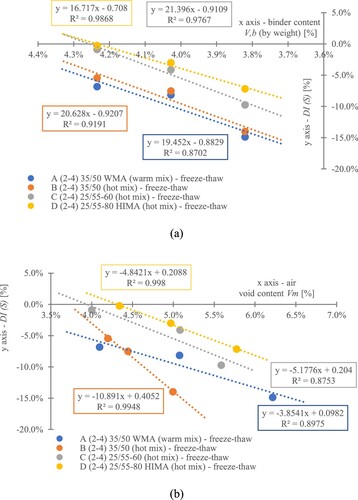
4. Summary and conclusions
The article focuses on the significant problem of the impact of water, frost, and salt on asphalt mixtures. Two proprietary experimental research methods using the dynamic 4-PB test were used. They made it possible to effectively determine the material degradation caused by water and frost or road salt through changes in the value of the stiffness modulus. Four types of mixtures were prepared for the research, differing only in the type of binder, its content, and technology. This way, the research problem, which was the degradation of mixtures caused by water and frost or road salt, was comprehensively discussed. Based on the obtained results, the degradation ratio was developed based on changes in the value of the module. It made it easier to assess and analyse the influence of environmental factors on the mixtures. Moreover, it allowed finding correlations between the tested levels of binder content in mixtures and other research methods (e.g. ITSR, static indirect tensile test ITT).
Based on the research and analyses, eight important conclusions were specified.
The water, frost, and road salt impact caused the mixture degradation of the material, determined by the stiffness modulus. The changes were significant – they caused a drop by as much as about 15% of the initial value of the module. It should be considered to examine and take into account these factors in the durability of the material and the designed pavement constructions. The topic of environmental factors should be successively developed.
The degradation of mixtures depends on the type and content of the binder used in the mixture and the considered impact. Among the tested mixtures, the highest resistance to water and frost and road salt impact was gathered by mix containing highly modified asphalt 25/55–80 HIMA (high content of SBS polymer in the asphalt matrix) (even up to 28.4 times higher for
and up to 2.88 times higher for
in relation to the WMA mixture). The worst resistance was represented by a mixture made in the warm technology, containing conventional 35/50 WMA road asphalt. This susceptibility to environmental factors was likely increased by the influence of additives reducing the production temperature.
The proposed experimental research methods allowed to study the water, frost and salt impact on mixtures referred to the stiffness modulus changes. Their effectiveness has been demonstrated. In addition, the obtained results represent a good correlation with the ITSR ratio, regarding to water and frost, as well as road salt impact. The applied linear regression model was characterised by a very high value of the coefficient of determination – above 0.87.
The authorship methods usage allows for a comprehensive and easier study of the environmental impact on mixtures. Simultaneously, the proposed methodology allows to the material re-usage for further tests, e.g. fatigue tests. It could help to determine the environmental impact on the fatigue life of the material (which is impossible in the case of the static ITT test).
The increase in the SBS polymer content in the asphalt matrix allows to increase mix resistance to water, frost, and road salt even up to 3.66 times (comparison through tested mixes).
The tested mixture based on road asphalt 35/50 made in hot technology (HMA), depending on the considered: impact and binder content, represented up to 1.25 times higher resistance than the alternative mixture (asphalt 35/50 WMA) made in the warm technology (WMA). The hot mix technology enables the material to be more resistant to environmental factors.
The impact of road salt on the mixtures caused a more minor but equally significant degradation of MMA in relation to water and frost. The topic of road salts’ impact is significant and should be deeply investigated in mixes and asphalt binders.
The developed authorship ratio
based on stiffness modulus value variability in the 4-PB test, allows analysing the degradation of mixtures caused by water and frost as well as road salt effectively. It is also helpful in finding the correlation of mixture degradation (stiffness changes) with other test methods or other crucial mixture features. It could also be implemented in pavement modelling to estimate its durability. It will be the subsequent case of study.
Disclosure statement
No potential conflict of interest was reported by the author(s).
References
- Almasi, S. A., & Khabir, M. M. (2019). Experimental evaluation of calcium chloride powder effect on the reduction of the pavement surface layer performance. Stavební Obzor - Civil Engineering Journal, 28(1), 61–72. https://doi.org/10.14311/CEJ.2019.01.0006
- American Association of State Highway and Transportation. (2021). Standard method of test for resistance of compacted asphalt mixtures to moisture-induced damage (T 283). American Association of State Highway and Transportation Officials (AASHTO).
- Amini, B., & Tehrani, S. S. (2014). Simultaneous effects of salted water and water flow on asphalt concrete pavement deterioration under freeze–thaw cycles. International Journal of Pavement Engineering, 15(5), 383–391. https://doi.org/10.1080/10298436.2012.677844
- Błażejowski, K., Ostrowski, P., Wójcik-Wiśniewska, M., & Baranowska, W. (2020). Mixes and pavements with Orbiton HIMA asphalts (Polish). Płock: Orlen Asfalt Sp. z o.o. https://www.orlen-asfalt.pl/PL/InformacjeTechniczne/Strony/Nasze-Publikacje.aspx
- Błażejowski, K., Wójcik-Wiśniewska, M., Baranowska, W., & Ostrowski, P. (2021). 2021 Poradnik Asfaltowy. Płock: Orlen Asfalt Sp. z o.o.
- Cheraghian, G., Cannone Falchetto, A., You, Z., Chen, S., Kim, Y. S., Westerhoff, J., Moon, K. H., & Wistuba, M. P. (2020). Warm mix asphalt technology: An up to date review. Journal of Cleaner Production, 268, 122128. https://doi.org/10.1016/j.jclepro.2020.122128
- Cominsky, R. J. (1994). The superpave mix design manual for new construction and overlays (SHRP A-407). National Research Council. https://onlinepubs.trb.org/onlinepubs/shrp/SHRP-A-407.pdf
- Cui, S., Guo, N., Wang, L., You, Z., Tan, Y., Guo, Z., Luo, X., & Chen, Z. (2022). Effect of freeze–thaw cycles on the pavement performance of SBS modified and composite crumb rubber modified asphalt mixtures. Construction and Building Materials, 342, 127799. https://doi.org/10.1016/j.conbuildmat.2022.127799
- Feng, B., Wang, H., Li, S., Ji, K., Li, L. [., & Xiong, R. (2022). The durability of asphalt mixture with the action of salt erosion: A review. Construction and Building Materials, 315, 125749. https://doi.org/10.1016/j.conbuildmat.2021.125749
- Generalna Dyrekcja Dróg Krajowych i Autostrad. (2014). Nawierzchnie asfaltowe na drogach krajowych: WT-2 2014 - część I Mieszanki mineralno-asfaltowe - wymagania techniczne. Generalna Dyrekcja Dróg Krajowych i Autostrad. https://www.gov.pl/attachment/34584de6-9577-4d36-876a-2e11c703128c
- Generalna Dyrekcja Dróg Krajowych i Autostrad. (2017a, September 5). Wytyczne zimowego utrzymania dróg - zarządzenie nr 31. Generalna Dyrekcja Dróg Krajowych i Autostrad. https://www.archiwum.gddkia.gov.pl/userfiles/articles/z/zarzadzenia-generalnego-dyrektor_24305/zarzadzenie%2031.pdf
- Generalna Dyrekcja Dróg Krajowych i Autostrad. (2017b, September 21). Standardy zimowego utrzymania dróg - zał. nr 1 do zarządzenia nr 32. https://www.archiwum.gddkia.gov.pl/userfiles/articles/z/zarzadzenia-generalnego-dyrektor_24305/zarzadzenie%2032%20zalacznik.pdf
- Generalna Dyrekcja Dróg Krajowych i Autostrad. (2017c, September 21). Standardy zimowego utrzymania dróg - zarządzenie nr 32. https://www.archiwum.gddkia.gov.pl/userfiles/articles/z/zarzadzenia-generalnego-dyrektor_24305/zarzadzenie%2032.pdf
- Godwin, K. S., Hafner, S. D., & Buff, M. F. (2003). Long-term trends in sodium and chloride in the Mohawk River: New York: The effect of fifty years of road-salt application. Environmental Pollution, 124(2), 273–281. https://doi.org/10.1016/S0269-7491(02)00481-5
- Government of Canada. (2001). Priority substances list assessment report - Road salts. Priority substances list assessment report. Environment Canada.
- Guidelines for the Selection of Snow and Ice Control Materials to Mitigate Environmental Impacts. (2007). Transportation Research Board, ISBN: 978-0-309-42233-8, https://doi.org/10.17226/23178
- Haponiuk, B., & Zbiciak, A. (2016). Mechanistic-empirical asphalt pavement design considering the effect of seasonal temperature variations. Archives of Civil Engineering, 62(4), https://doi.org/10.1515/ace-2015-0096
- Harrigan, E. T., & Leahy, R. B. (1994). The SUPERPAVE mix design system, manual of specifications (SHRP A-379). Washington, D.C.: National Research Council. https://onlinepubs.trb.org/onlinepubs/shrp/SHRP-A-379.pdf
- Hassan, Y., Halim, A. E., Razaqpur, A. O., Bekheet, A. G., & Farha, W., & H, M. (2002). Effects of runway deicers on pavement materials and mixes: Comparison with Road Salt. Journal of Transportation Engineering, 128(4), 385–391. https://doi.org/10.1061/(ASCE)0733-947X(2002)128:4(385)
- Hossain, S. K., Fu, L., Hosseini, F., Muresan, M., Donnelly, T., & Kabir, S. (2016). Optimum winter road maintenance: Effect of pavement types on snow melting performance of road salts. Canadian Journal of Civil Engineering, 43(9), 802–811. https://doi.org/10.1139/cjce-2016-0010
- Hugenschmidt, J., & Loser, R. (2008). Detection of chlorides and moisture in concrete structures with ground penetrating radar. Materials and Structures, 41(4), 785–792. https://doi.org/10.1617/s11527-007-9282-5
- Industrial experimental department of road and bridge engineering Sp. z o.o. (2004). General technical specification D - 10.10.01c combating winter slippy on the road (Polish), Warsaw 2004. https://www.bip.powiattorunski.pl/plik,43153,ost-pdf.pdf
- Jaskula, P., & Judycki, J. (2014). The effect of water and frost on fatigue life of asphalt concrete. Geo-Hubei 2014 International Conference on Sustainable Civil Infrastructure (255), 76–83. https://doi.org/10.1061/9780784478554.010
- Jaskula, P., & Judycki, J. (2016). Durability of asphalt concrete subjected to deteriorating effects of water and frost. Journal of Performance of Constructed Facilities, 30(1), C4014004. https://doi.org/10.1061/(ASCE)CF.1943-5509.0000645
- Ji, J., Li, P., Chen, M., Zhang, R., Zhou, W., & You, Z. (2021). Review on the fatigue properties of recycled asphalt concrete containing construction and demolition wastes. Journal of Cleaner Production, 327, 129478. https://doi.org/10.1016/j.jclepro.2021.129478
- Judycki, J. (2014). Analizy i projektowanie konstrukcji nawierzchni podatnych i półsztywnych: Praca zbiorowa. WKiŁ.
- Judycki, J., Jaskula, P., Alenowicz, J., Dołżycki, B., Jaczewski, M., Ryś, D., & Stienss, M. (2014). Catalog of typical pavement constructions for flexible and semi-rigid pavement (Polish). Generalna Dyrekcja Dróg Krajowych i Autostrad. https://www.gddkia.gov.pl/frontend/web/userfiles/articles/d/dokumenty-techniczne_8162/Dokumenty%20techniczne/KTKNPiP.pdf
- Juli-Gándara, L., Vega-Zamanillo, Á, & Calzada-Pérez, MÁ. (2019). Sodium chloride effect in the mechanical properties of the bituminous mixtures. Cold Regions Science and Technology, 164, 102776. https://doi.org/10.1016/j.coldregions.2019.05.002
- Juli-Gándara, L., Vega-Zamanillo, Á, Calzada-Pérez, MÁ, & Teijón-López-Zuazo, E. (2020). Effect of sodium chloride on the modulus and fatigue life of bituminous mixtures. Materials (Basel, Switzerland), 13(9), https://doi.org/10.3390/ma13092126
- Kakar, M. R., Hamzah, M. O., & Valentin, J. (2015). A review on moisture damages of hot and warm mix asphalt and related investigations. Journal of Cleaner Production, 99, 39–58. https://doi.org/10.1016/j.jclepro.2015.03.028
- Karimi, M. M., Amani, S., Jahanbakhsh, H., Jahangiri, B., & Alavi, A. H. (2021). Induced heating-healing of conductive asphalt concrete as a sustainable repairing technique: A review. Cleaner Engineering and Technology, 4, 100188. https://doi.org/10.1016/j.clet.2021.100188
- Kelly, V. R., Findaly, S. E. G., Schlesinger, W. H., Menking, K., & Chatrchyan, A. M. (2010). Road salt - moving toward the solution. The Cary Institute of Ecosystem Studies. https://www.caryinstitute.org/sites/default/files/public/reprints/report_road_salt_2010.pdf
- Kelly, V. R., Lovett, G. M., Weathers, K. C., Findlay, S. E. G., Strayer, D. L., Burns, D. I., & Likens, G. E. (2008). Long-term sodium chloride retention in a rural watershed: Legacy effects of road salt on streamwater concentration. Environmental Science & Technology, 42(2), 410–415. https://doi.org/10.1021/es071391l
- Kosior-Kazberuk, M., & Jezierski, W. (2004). Surface scaling resistance of concrete modified with bituminous addition. Journal of Civil Engineering and Management, 10(1), 25–30. https://doi.org/10.3846/13923730.2004.9636282
- Lamothe, S., Perraton, D., & Di Benedetto, H. (2017). Degradation of hot mix asphalt samples subjected to freeze-thaw cycles and partially saturated with water or brine. Road Materials and Pavement Design, 18(4), 849–864. https://doi.org/10.1080/14680629.2017.1286442
- Leszczyńska, W., & Pszczoła, M. (2021). Analiza temperatury ekwiwalentnej do projektowania nawierzchni asfaltowych w Polsce z wykorzystaniem metody AASHTO 2004. Przegląd Komunikacyjny, R. 76, nr 4. https://yadda.icm.edu.pl/baztech/element/bwmeta1.element.baztech-29999f2d-9654-4a66-94c0-66090de8474b
- Liu, Y. H., Zhang, H., Wang, X. L., & Li, L. (2014). The weakening effect of the snow-melting agent on the performance of municipal asphalt pavement in the severe cold region. Advanced Materials Research, 953-954, 1604–1608. https://doi.org/10.4028/www.scientific.net/AMR.953-954.1604
- Lottman, R. P. (1982). Predicting moisture-induced damage to asphaltic concrete. Field evaluation. NCHRP: Vol. 246.
- Lottman, R. P., White, L. J., & Frith, D. J. (1988). Methods of predicting and controlling moisture damage in asphalt concrete. https://www.researchgate.net/publication/312898075_Methods_of_predicting_and_controlling_moisture_damage_in_asphalt_concrete
- Mackiewicz, P. (2016). Trwałość zmęczeniowa mieszanek mineralno-asfaltowych stosowanych w nawierzchniach drogowych. Oficyna Wydawnicza Politechniki Wrocławskiej; Politechnika Wrocławska.
- Mackiewicz, P., & Krawczyk, B. (2022). Identification of parameters and fatigue life assessment of the road pavement lower construction layers under heavy construction traffic. Materials (Basel, Switzerland), 15(16), https://doi.org/10.3390/ma15165646
- Mackiewicz, P., & Mączka, E. (2021). The impact of water and road salt with anti-caking agent on the stiffness of select mixes used for the road surface. Materials (Basel, Switzerland), 14(6), https://doi.org/10.3390/ma14061345
- Mączka, E. (2022). The durability of asphalt mixtures including fatigue and regeneration phenomenon (PRE/06/2022) [PhD]. Wroclaw University of Science and Technology, Wroclaw University of Science and Technology.
- Mączka, E., & Mackiewicz, P. (2022). Asphalt mixtures and flexible pavement construction degradation considering different environmental factors. Applied Sciences, 12(23), 12068. https://doi.org/10.3390/app122312068
- Özgan, E., & Serin, S. (2012). Investigation of certain engineering characteristics of asphalt concrete exposed to freeze–thaw cycles. Cold Regions Science and Technology, 85, 131–136. https://doi.org/10.1016/j.coldregions.2012.09.003
- Pan, P., Wu, S., Hu, X., Wang, P., & Liu, Q. (2017). Effect of freezing-thawing and ageing on thermal characteristics and mechanical properties of conductive asphalt concrete. Construction and Building Materials, 140, 239–247. https://doi.org/10.1016/j.conbuildmat.2017.02.135
- Piłat, J., Radziszewski, P., & Król, J. (2015). Technologia materiałów i nawierzchni asfaltowych. Oficyna Wydawnicza Politechniki Warszawskiej. ISBN: 9788378144441.
- Piotr Jaskuła. (2004). Deteriorating effects of water and frost on asphalt mixes – state of the art. Roads and Bridges - Drogi I Mosty, 3(4), 5–44. https://www.rabdim.pl/index.php/rb/article/view/v3n4p5/213
- Polski Komitet Normalizacyjny. (2016a). Bituminous mixtures – Material specifications – Part 1: Asphalt Concrete: PN-EN 13108-1:2016-07 (PN-EN 13108-1:2016-07). Warsaw. PKN.
- Polski Komitet Normalizacyjny. (2016b). Bituminous mixtures – Material specifications – Part 20: Type testing: PN-EN 13108-20:2016-07 (PN-EN 13108-20:2016-07). Warsaw. PKN.
- Polski Komitet Normalizacyjny. (2018). Bituminous mixtures – Test methods – Part 26: Stiffness: PN-EN 12697-26:2018-08 (PN-EN 12697-26:2018-08). Warsaw. PKN.
- Polski Komitet Normalizacyjny. (2020). Bituminous mixtures – Test methods – Part 6: Determination of bulk density of bituminous specimens: PN-EN 12697-6:2020-07 (PN-EN 12697-6:2020-07). Warsaw. PKN.
- Pszczoła, M. (2018). Temperatura ekwiwalentna do projektowania nawierzchni asfaltowych w Polsce. https://doi.org/10.13140/RG.2.2.17712.00008
- Rodrigues, P. M., Rodrigues, R. M., Costa, B. H., Tavares Martins, A. A., & Da Esteves Silva, J. C. (2010). Multivariate analysis of the water quality variation in the Serra da Estrela (Portugal) Natural Park as a consequence of road deicing with salt. Chemometrics and Intelligent Laboratory Systems, 102(2), 130–135. https://doi.org/10.1016/j.chemolab.2010.04.014
- Said, S. (1989). Tensile and fatigue properties of bituminous mixtures using the indirect tensile method. Undefined. https://www.semanticscholar.org/paper/TENSILE-AND-FATIGUE-PROPERTIES-OF-BITUMINOUS-USING-Said/85795cab9973612af49eaa4e661f81f9c9927ee2
- saideep Pavuluri. (2014). Kinetic approach for modeling salt precipitation in porous-media. (2828112) [Independent Study]. Universitat Stuttgart, Stuttgart. https://www.researchgate.net/publication/262495450_Kinetic_approach_for_modeling_salt_precipitation_in_porous-media
- Saltanovs, R., Rubenis, A., & Krainyukov, A. (2019). Influence of constructive materials of road cover on magnetic field dispersion of wireless power transmission systems. In I. Kabashkin, I. Yatskiv, & O. Prentkovskis (Eds.), Lecture notes in networks and systems. Reliability and statistics in transportation and communication (Vol. 68, pp. 214–223). Springer International Publishing. https://doi.org/10.1007/978-3-030-12450-2_20
- Sanfilippo, D., Garcia-Hernández, A., Alexiadis, A., & Ghiassi, B. (2022). Effect of freeze–thaw cycles on the void topologies and mechanical properties of asphalt. Construction and Building Materials, 344, 128085. https://doi.org/10.1016/j.conbuildmat.2022.128085
- Sybilski, D., & Bańkowski, W. (2004). Temperatura równoważna nawierzchni asfaltowej ze względu na zmęczenie w polskich warunkach klimatycznych. Drogownictwo,: nr 6, 179–184. http://yadda.icm.edu.pl/yadda/element/bwmeta1.element.baztech-article-BAT1-0005-0022
- Tarefder, R., Faisal, H., & Barlas, G. (2018). Freeze-thaw effects on fatigue LIFE of hot mix asphalt and creep stiffness of asphalt binder. Cold Regions Science and Technology, 153, 197–204. https://doi.org/10.1016/j.coldregions.2018.02.011
- Trost, S. E., Heng, F. J., & Cussler, E. L. (1987). Chemistry of deicing roads: Breaking the bond between ice and road. Journal of Transportation Engineering, 113(1), 15–26. https://doi.org/10.1061/(ASCE)0733-947X(1987)113:1(15)
- Tsang, C., Shehata, M. H., & Lotfy, A. (2016). Optimizing a test method to evaluate resistance of pervious concrete to cycles of freezing and thawing in the presence of different deicing salts. Materials (Basel, Switzerland), 9(11), https://doi.org/10.3390/ma9110878
- ud Din, I. M., Mir, M. S., & Farooq, M. A. (2020). Effect of freeze-thaw cycles on the properties of asphalt pavements in cold regions: A review. Transportation Research Procedia, 48, 3634–3641. https://doi.org/10.1016/j.trpro.2020.08.087
- Vega-Zamanillo, Á, Juli-Gándara, L., Calzada-Pérez, MÁ, & Teijón-López-Zuazo, E. (2020). Impact of temperature changes and freeze—thaw cycles on the behaviour of asphalt concrete submerged in water with sodium chloride. Applied Sciences, 10(4), 1241. https://doi.org/10.3390/app10041241
- Vega-Zamanillo, Á, Juli-Gándara, L., Calzada-Pérez, M. A., & Teijón-López-Zuazo, E. (2021). Study on the conservation of bituminous mixes in high mountain roads and coastal zones. Transportation Research Procedia, 58, 325–332. https://doi.org/10.1016/j.trpro.2021.11.044
- Zhang, X., Hoff, I., & Chen, H. (2022). Characterization of various bitumen exposed to environmental chemicals. Journal of Cleaner Production, 337, 130610. https://doi.org/10.1016/j.jclepro.2022.130610
- Zhang, Z., Liu, Q., Wu, Q., Xu, H., Liu, P., & Oeser, M. (2021). Damage evolution of asphalt mixture under freeze-thaw cyclic loading from a mechanical perspective. International Journal of Fatigue, 142, 105923. https://doi.org/10.1016/j.ijfatigue.2020.105923
- Zheng, Y., Cai, Y., Zhang, G., & Fang, H. (2014). Fatigue property of basalt fiber-modified asphalt mixture under complicated environment. Journal of Wuhan University of Technology-Mater. Sci. Ed, 29(5), 996–1004. https://doi.org/10.1007/s11595-014-1033-1
- Zhou, Z., Li, H., Liu, X., & He, W. (2020). Investigation of sea salt erosion effect on the asphalt-aggregate interfacial system. International Journal of Pavement Research and Technology, 13(2), 145–153. https://doi.org/10.1007/s42947-019-0095-2


